Financial Control and Budgeting: NHS and Stakeholder Analysis
VerifiedAdded on 2022/12/26
|16
|5452
|1
Report
AI Summary
This report delves into the intricacies of financial control and budgeting within the health and social care sector, specifically focusing on the National Health Service (NHS). It begins by examining the legal, financial, and regulatory frameworks that govern the industry, highlighting the importance of these structures in ensuring ethical and effective practices. The report then evaluates various alternate funding options available to the sector, such as Private Finance Initiatives (PFI), agency partnerships, competitive tendering, and outsourcing, analyzing their advantages and disadvantages. Agency theory is explored in the context of the NHS, emphasizing the significance of budgeting and effective communication with stakeholders. The impact of financial constraints, costs, and budgets on health and social care service managers, their clients, and other stakeholders is thoroughly assessed. The report also investigates the particular challenges of budgeting in public sector organizations and compares the advantages and disadvantages of incremental and zero-based budgeting. Finally, the report includes a calculation of the break-even point and margin of safety, along with a discussion of the assumptions inherent in the break-even model as they relate to the current business environment.

Financial control
and
Budgeting
and
Budgeting
Paraphrase This Document
Need a fresh take? Get an instant paraphrase of this document with our AI Paraphraser
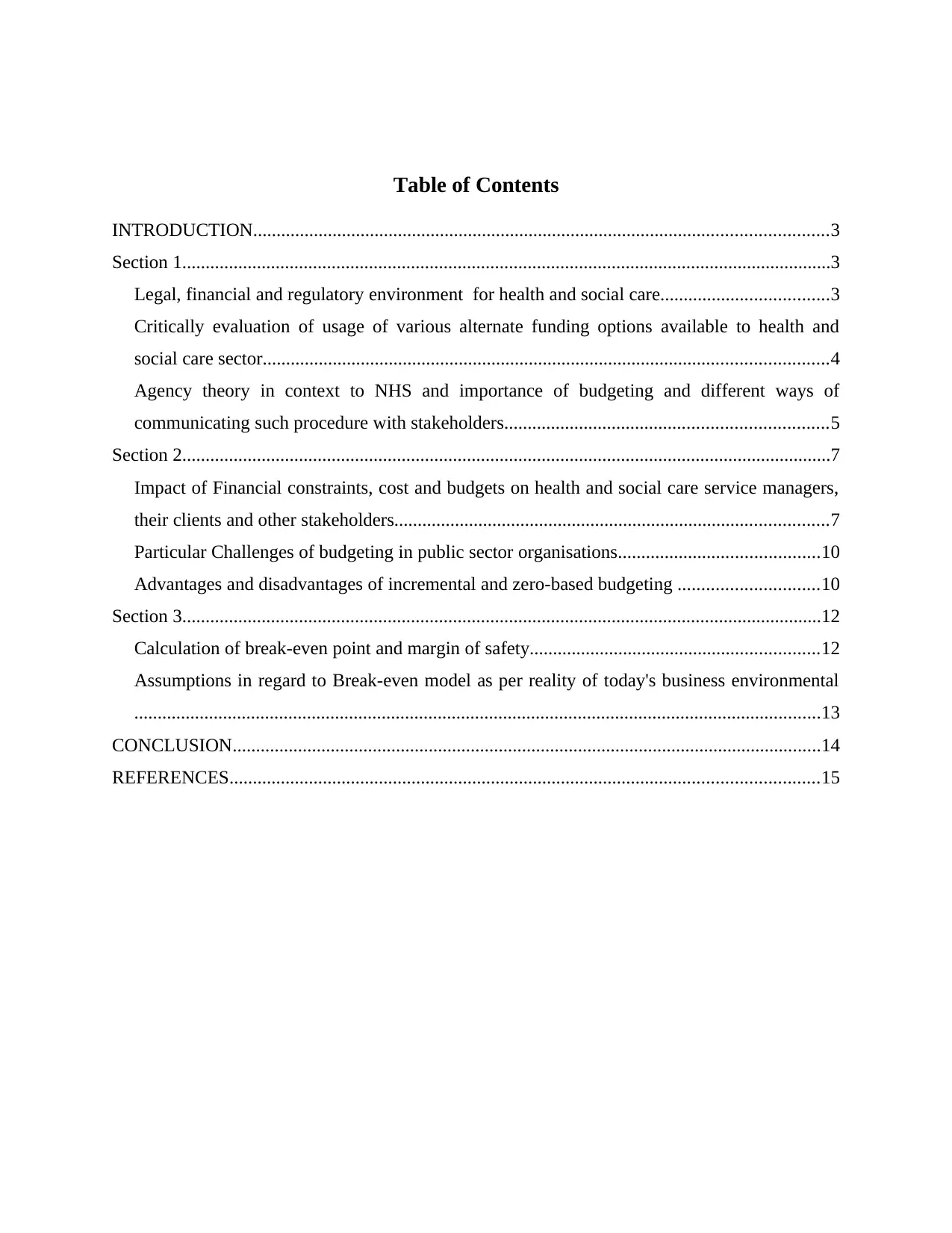
Table of Contents
INTRODUCTION...........................................................................................................................3
Section 1...........................................................................................................................................3
Legal, financial and regulatory environment for health and social care....................................3
Critically evaluation of usage of various alternate funding options available to health and
social care sector.........................................................................................................................4
Agency theory in context to NHS and importance of budgeting and different ways of
communicating such procedure with stakeholders.....................................................................5
Section 2...........................................................................................................................................7
Impact of Financial constraints, cost and budgets on health and social care service managers,
their clients and other stakeholders.............................................................................................7
Particular Challenges of budgeting in public sector organisations...........................................10
Advantages and disadvantages of incremental and zero-based budgeting ..............................10
Section 3.........................................................................................................................................12
Calculation of break-even point and margin of safety..............................................................12
Assumptions in regard to Break-even model as per reality of today's business environmental
...................................................................................................................................................13
CONCLUSION..............................................................................................................................14
REFERENCES..............................................................................................................................15
INTRODUCTION...........................................................................................................................3
Section 1...........................................................................................................................................3
Legal, financial and regulatory environment for health and social care....................................3
Critically evaluation of usage of various alternate funding options available to health and
social care sector.........................................................................................................................4
Agency theory in context to NHS and importance of budgeting and different ways of
communicating such procedure with stakeholders.....................................................................5
Section 2...........................................................................................................................................7
Impact of Financial constraints, cost and budgets on health and social care service managers,
their clients and other stakeholders.............................................................................................7
Particular Challenges of budgeting in public sector organisations...........................................10
Advantages and disadvantages of incremental and zero-based budgeting ..............................10
Section 3.........................................................................................................................................12
Calculation of break-even point and margin of safety..............................................................12
Assumptions in regard to Break-even model as per reality of today's business environmental
...................................................................................................................................................13
CONCLUSION..............................................................................................................................14
REFERENCES..............................................................................................................................15
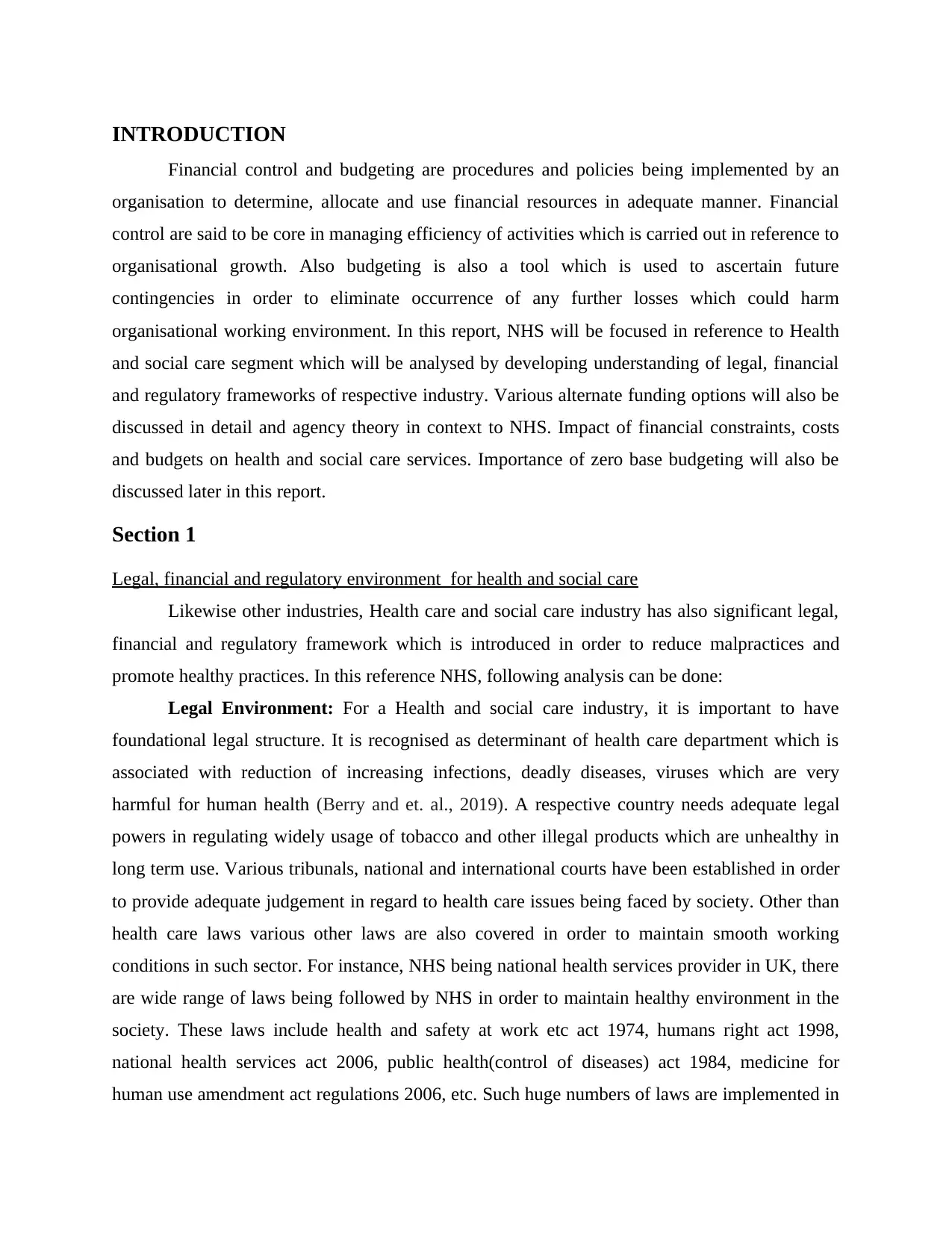
INTRODUCTION
Financial control and budgeting are procedures and policies being implemented by an
organisation to determine, allocate and use financial resources in adequate manner. Financial
control are said to be core in managing efficiency of activities which is carried out in reference to
organisational growth. Also budgeting is also a tool which is used to ascertain future
contingencies in order to eliminate occurrence of any further losses which could harm
organisational working environment. In this report, NHS will be focused in reference to Health
and social care segment which will be analysed by developing understanding of legal, financial
and regulatory frameworks of respective industry. Various alternate funding options will also be
discussed in detail and agency theory in context to NHS. Impact of financial constraints, costs
and budgets on health and social care services. Importance of zero base budgeting will also be
discussed later in this report.
Section 1
Legal, financial and regulatory environment for health and social care
Likewise other industries, Health care and social care industry has also significant legal,
financial and regulatory framework which is introduced in order to reduce malpractices and
promote healthy practices. In this reference NHS, following analysis can be done:
Legal Environment: For a Health and social care industry, it is important to have
foundational legal structure. It is recognised as determinant of health care department which is
associated with reduction of increasing infections, deadly diseases, viruses which are very
harmful for human health (Berry and et. al., 2019). A respective country needs adequate legal
powers in regulating widely usage of tobacco and other illegal products which are unhealthy in
long term use. Various tribunals, national and international courts have been established in order
to provide adequate judgement in regard to health care issues being faced by society. Other than
health care laws various other laws are also covered in order to maintain smooth working
conditions in such sector. For instance, NHS being national health services provider in UK, there
are wide range of laws being followed by NHS in order to maintain healthy environment in the
society. These laws include health and safety at work etc act 1974, humans right act 1998,
national health services act 2006, public health(control of diseases) act 1984, medicine for
human use amendment act regulations 2006, etc. Such huge numbers of laws are implemented in
Financial control and budgeting are procedures and policies being implemented by an
organisation to determine, allocate and use financial resources in adequate manner. Financial
control are said to be core in managing efficiency of activities which is carried out in reference to
organisational growth. Also budgeting is also a tool which is used to ascertain future
contingencies in order to eliminate occurrence of any further losses which could harm
organisational working environment. In this report, NHS will be focused in reference to Health
and social care segment which will be analysed by developing understanding of legal, financial
and regulatory frameworks of respective industry. Various alternate funding options will also be
discussed in detail and agency theory in context to NHS. Impact of financial constraints, costs
and budgets on health and social care services. Importance of zero base budgeting will also be
discussed later in this report.
Section 1
Legal, financial and regulatory environment for health and social care
Likewise other industries, Health care and social care industry has also significant legal,
financial and regulatory framework which is introduced in order to reduce malpractices and
promote healthy practices. In this reference NHS, following analysis can be done:
Legal Environment: For a Health and social care industry, it is important to have
foundational legal structure. It is recognised as determinant of health care department which is
associated with reduction of increasing infections, deadly diseases, viruses which are very
harmful for human health (Berry and et. al., 2019). A respective country needs adequate legal
powers in regulating widely usage of tobacco and other illegal products which are unhealthy in
long term use. Various tribunals, national and international courts have been established in order
to provide adequate judgement in regard to health care issues being faced by society. Other than
health care laws various other laws are also covered in order to maintain smooth working
conditions in such sector. For instance, NHS being national health services provider in UK, there
are wide range of laws being followed by NHS in order to maintain healthy environment in the
society. These laws include health and safety at work etc act 1974, humans right act 1998,
national health services act 2006, public health(control of diseases) act 1984, medicine for
human use amendment act regulations 2006, etc. Such huge numbers of laws are implemented in
⊘ This is a preview!⊘
Do you want full access?
Subscribe today to unlock all pages.

Trusted by 1+ million students worldwide
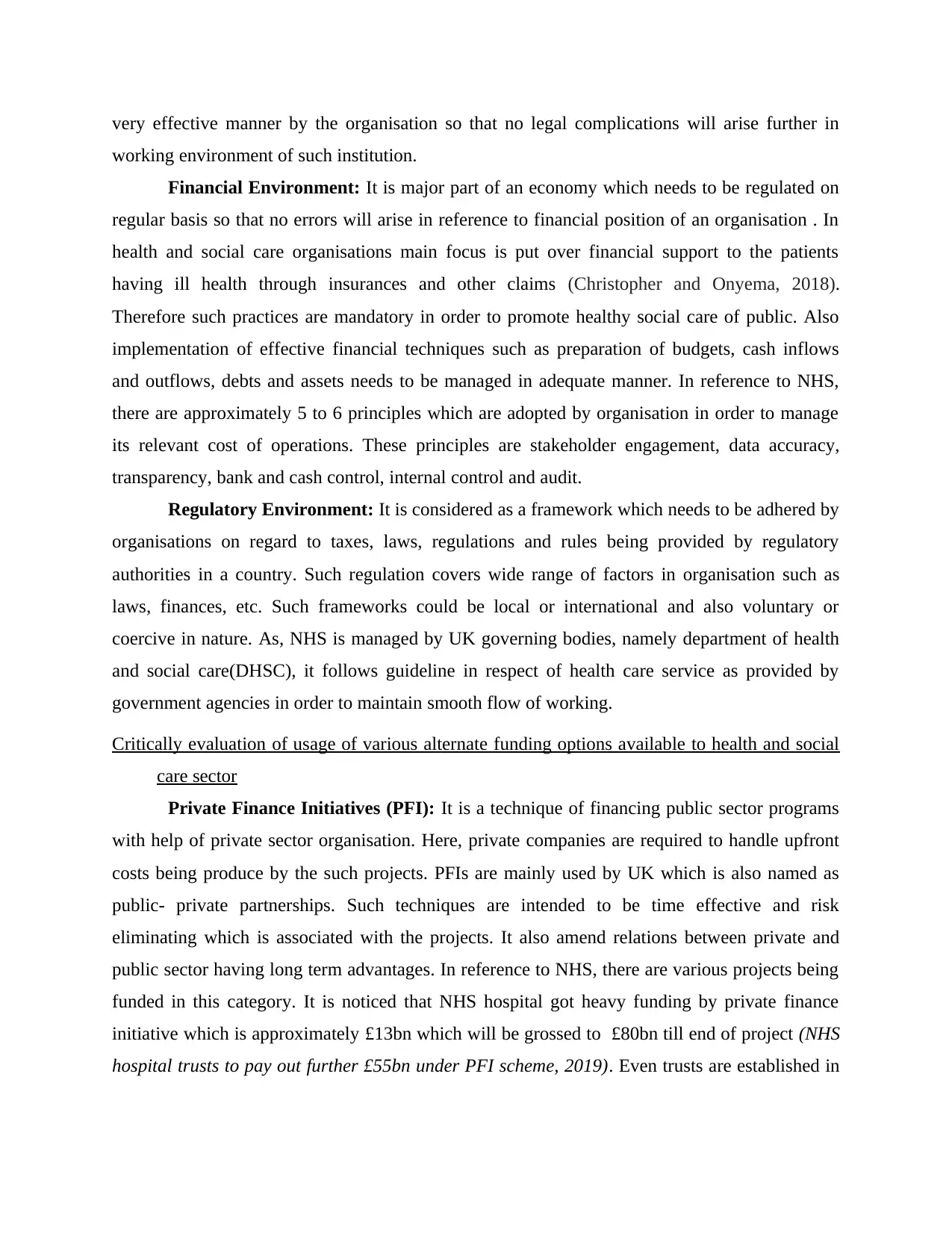
very effective manner by the organisation so that no legal complications will arise further in
working environment of such institution.
Financial Environment: It is major part of an economy which needs to be regulated on
regular basis so that no errors will arise in reference to financial position of an organisation . In
health and social care organisations main focus is put over financial support to the patients
having ill health through insurances and other claims (Christopher and Onyema, 2018).
Therefore such practices are mandatory in order to promote healthy social care of public. Also
implementation of effective financial techniques such as preparation of budgets, cash inflows
and outflows, debts and assets needs to be managed in adequate manner. In reference to NHS,
there are approximately 5 to 6 principles which are adopted by organisation in order to manage
its relevant cost of operations. These principles are stakeholder engagement, data accuracy,
transparency, bank and cash control, internal control and audit.
Regulatory Environment: It is considered as a framework which needs to be adhered by
organisations on regard to taxes, laws, regulations and rules being provided by regulatory
authorities in a country. Such regulation covers wide range of factors in organisation such as
laws, finances, etc. Such frameworks could be local or international and also voluntary or
coercive in nature. As, NHS is managed by UK governing bodies, namely department of health
and social care(DHSC), it follows guideline in respect of health care service as provided by
government agencies in order to maintain smooth flow of working.
Critically evaluation of usage of various alternate funding options available to health and social
care sector
Private Finance Initiatives (PFI): It is a technique of financing public sector programs
with help of private sector organisation. Here, private companies are required to handle upfront
costs being produce by the such projects. PFIs are mainly used by UK which is also named as
public- private partnerships. Such techniques are intended to be time effective and risk
eliminating which is associated with the projects. It also amend relations between private and
public sector having long term advantages. In reference to NHS, there are various projects being
funded in this category. It is noticed that NHS hospital got heavy funding by private finance
initiative which is approximately £13bn which will be grossed to £80bn till end of project (NHS
hospital trusts to pay out further £55bn under PFI scheme, 2019). Even trusts are established in
working environment of such institution.
Financial Environment: It is major part of an economy which needs to be regulated on
regular basis so that no errors will arise in reference to financial position of an organisation . In
health and social care organisations main focus is put over financial support to the patients
having ill health through insurances and other claims (Christopher and Onyema, 2018).
Therefore such practices are mandatory in order to promote healthy social care of public. Also
implementation of effective financial techniques such as preparation of budgets, cash inflows
and outflows, debts and assets needs to be managed in adequate manner. In reference to NHS,
there are approximately 5 to 6 principles which are adopted by organisation in order to manage
its relevant cost of operations. These principles are stakeholder engagement, data accuracy,
transparency, bank and cash control, internal control and audit.
Regulatory Environment: It is considered as a framework which needs to be adhered by
organisations on regard to taxes, laws, regulations and rules being provided by regulatory
authorities in a country. Such regulation covers wide range of factors in organisation such as
laws, finances, etc. Such frameworks could be local or international and also voluntary or
coercive in nature. As, NHS is managed by UK governing bodies, namely department of health
and social care(DHSC), it follows guideline in respect of health care service as provided by
government agencies in order to maintain smooth flow of working.
Critically evaluation of usage of various alternate funding options available to health and social
care sector
Private Finance Initiatives (PFI): It is a technique of financing public sector programs
with help of private sector organisation. Here, private companies are required to handle upfront
costs being produce by the such projects. PFIs are mainly used by UK which is also named as
public- private partnerships. Such techniques are intended to be time effective and risk
eliminating which is associated with the projects. It also amend relations between private and
public sector having long term advantages. In reference to NHS, there are various projects being
funded in this category. It is noticed that NHS hospital got heavy funding by private finance
initiative which is approximately £13bn which will be grossed to £80bn till end of project (NHS
hospital trusts to pay out further £55bn under PFI scheme, 2019). Even trusts are established in
Paraphrase This Document
Need a fresh take? Get an instant paraphrase of this document with our AI Paraphraser
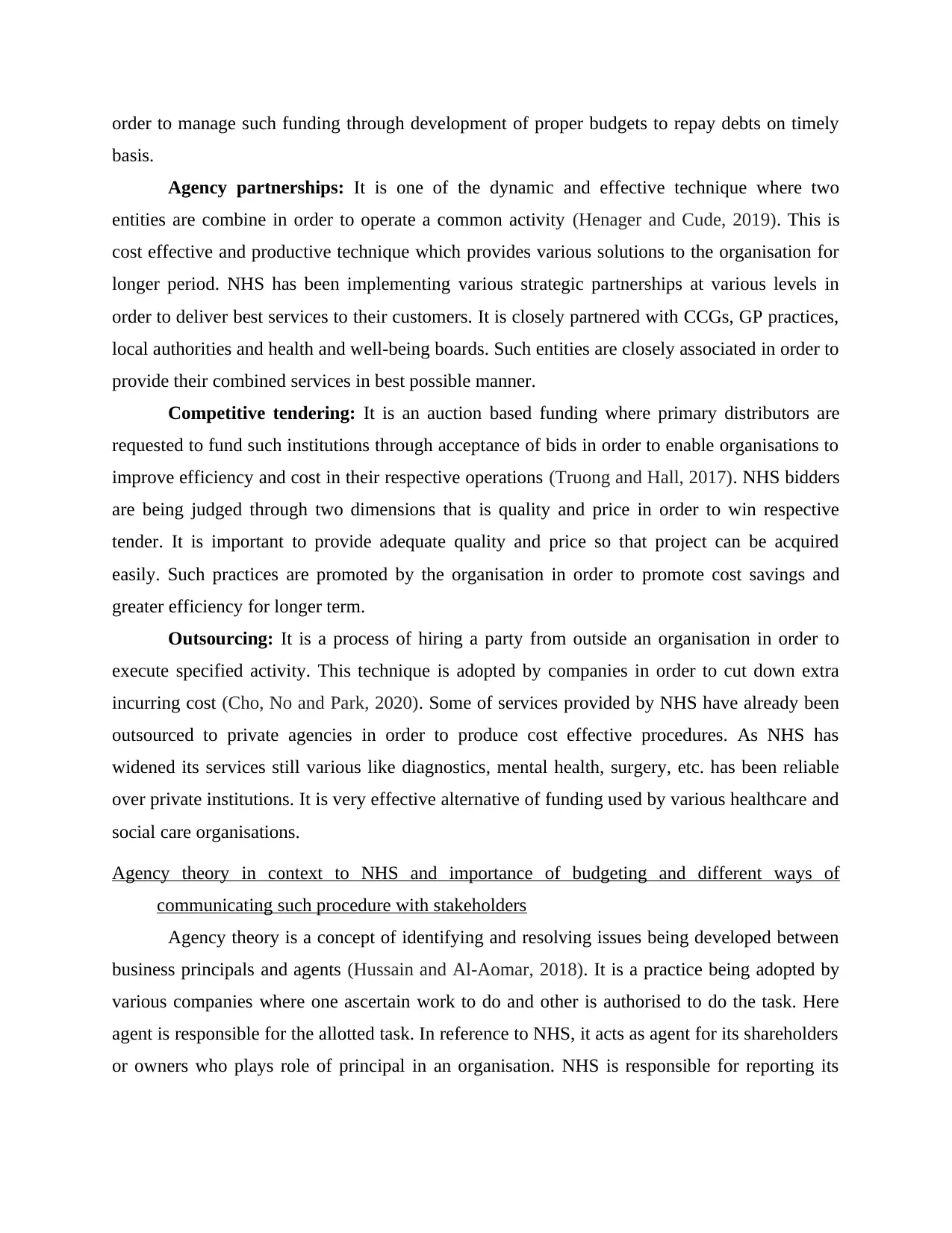
order to manage such funding through development of proper budgets to repay debts on timely
basis.
Agency partnerships: It is one of the dynamic and effective technique where two
entities are combine in order to operate a common activity (Henager and Cude, 2019). This is
cost effective and productive technique which provides various solutions to the organisation for
longer period. NHS has been implementing various strategic partnerships at various levels in
order to deliver best services to their customers. It is closely partnered with CCGs, GP practices,
local authorities and health and well-being boards. Such entities are closely associated in order to
provide their combined services in best possible manner.
Competitive tendering: It is an auction based funding where primary distributors are
requested to fund such institutions through acceptance of bids in order to enable organisations to
improve efficiency and cost in their respective operations (Truong and Hall, 2017). NHS bidders
are being judged through two dimensions that is quality and price in order to win respective
tender. It is important to provide adequate quality and price so that project can be acquired
easily. Such practices are promoted by the organisation in order to promote cost savings and
greater efficiency for longer term.
Outsourcing: It is a process of hiring a party from outside an organisation in order to
execute specified activity. This technique is adopted by companies in order to cut down extra
incurring cost (Cho, No and Park, 2020). Some of services provided by NHS have already been
outsourced to private agencies in order to produce cost effective procedures. As NHS has
widened its services still various like diagnostics, mental health, surgery, etc. has been reliable
over private institutions. It is very effective alternative of funding used by various healthcare and
social care organisations.
Agency theory in context to NHS and importance of budgeting and different ways of
communicating such procedure with stakeholders
Agency theory is a concept of identifying and resolving issues being developed between
business principals and agents (Hussain and Al-Aomar, 2018). It is a practice being adopted by
various companies where one ascertain work to do and other is authorised to do the task. Here
agent is responsible for the allotted task. In reference to NHS, it acts as agent for its shareholders
or owners who plays role of principal in an organisation. NHS is responsible for reporting its
basis.
Agency partnerships: It is one of the dynamic and effective technique where two
entities are combine in order to operate a common activity (Henager and Cude, 2019). This is
cost effective and productive technique which provides various solutions to the organisation for
longer period. NHS has been implementing various strategic partnerships at various levels in
order to deliver best services to their customers. It is closely partnered with CCGs, GP practices,
local authorities and health and well-being boards. Such entities are closely associated in order to
provide their combined services in best possible manner.
Competitive tendering: It is an auction based funding where primary distributors are
requested to fund such institutions through acceptance of bids in order to enable organisations to
improve efficiency and cost in their respective operations (Truong and Hall, 2017). NHS bidders
are being judged through two dimensions that is quality and price in order to win respective
tender. It is important to provide adequate quality and price so that project can be acquired
easily. Such practices are promoted by the organisation in order to promote cost savings and
greater efficiency for longer term.
Outsourcing: It is a process of hiring a party from outside an organisation in order to
execute specified activity. This technique is adopted by companies in order to cut down extra
incurring cost (Cho, No and Park, 2020). Some of services provided by NHS have already been
outsourced to private agencies in order to produce cost effective procedures. As NHS has
widened its services still various like diagnostics, mental health, surgery, etc. has been reliable
over private institutions. It is very effective alternative of funding used by various healthcare and
social care organisations.
Agency theory in context to NHS and importance of budgeting and different ways of
communicating such procedure with stakeholders
Agency theory is a concept of identifying and resolving issues being developed between
business principals and agents (Hussain and Al-Aomar, 2018). It is a practice being adopted by
various companies where one ascertain work to do and other is authorised to do the task. Here
agent is responsible for the allotted task. In reference to NHS, it acts as agent for its shareholders
or owners who plays role of principal in an organisation. NHS is responsible for reporting its
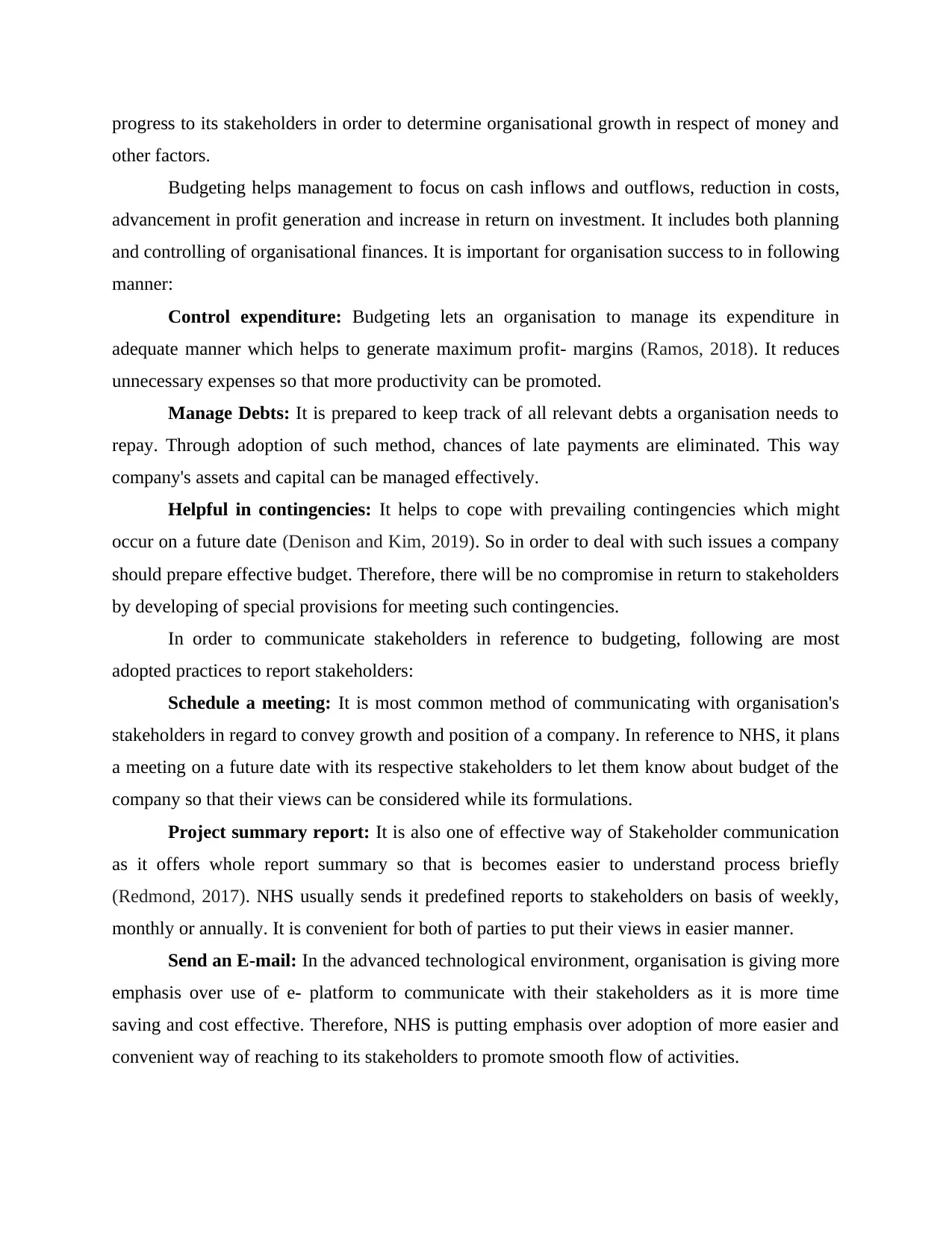
progress to its stakeholders in order to determine organisational growth in respect of money and
other factors.
Budgeting helps management to focus on cash inflows and outflows, reduction in costs,
advancement in profit generation and increase in return on investment. It includes both planning
and controlling of organisational finances. It is important for organisation success to in following
manner:
Control expenditure: Budgeting lets an organisation to manage its expenditure in
adequate manner which helps to generate maximum profit- margins (Ramos, 2018). It reduces
unnecessary expenses so that more productivity can be promoted.
Manage Debts: It is prepared to keep track of all relevant debts a organisation needs to
repay. Through adoption of such method, chances of late payments are eliminated. This way
company's assets and capital can be managed effectively.
Helpful in contingencies: It helps to cope with prevailing contingencies which might
occur on a future date (Denison and Kim, 2019). So in order to deal with such issues a company
should prepare effective budget. Therefore, there will be no compromise in return to stakeholders
by developing of special provisions for meeting such contingencies.
In order to communicate stakeholders in reference to budgeting, following are most
adopted practices to report stakeholders:
Schedule a meeting: It is most common method of communicating with organisation's
stakeholders in regard to convey growth and position of a company. In reference to NHS, it plans
a meeting on a future date with its respective stakeholders to let them know about budget of the
company so that their views can be considered while its formulations.
Project summary report: It is also one of effective way of Stakeholder communication
as it offers whole report summary so that is becomes easier to understand process briefly
(Redmond, 2017). NHS usually sends it predefined reports to stakeholders on basis of weekly,
monthly or annually. It is convenient for both of parties to put their views in easier manner.
Send an E-mail: In the advanced technological environment, organisation is giving more
emphasis over use of e- platform to communicate with their stakeholders as it is more time
saving and cost effective. Therefore, NHS is putting emphasis over adoption of more easier and
convenient way of reaching to its stakeholders to promote smooth flow of activities.
other factors.
Budgeting helps management to focus on cash inflows and outflows, reduction in costs,
advancement in profit generation and increase in return on investment. It includes both planning
and controlling of organisational finances. It is important for organisation success to in following
manner:
Control expenditure: Budgeting lets an organisation to manage its expenditure in
adequate manner which helps to generate maximum profit- margins (Ramos, 2018). It reduces
unnecessary expenses so that more productivity can be promoted.
Manage Debts: It is prepared to keep track of all relevant debts a organisation needs to
repay. Through adoption of such method, chances of late payments are eliminated. This way
company's assets and capital can be managed effectively.
Helpful in contingencies: It helps to cope with prevailing contingencies which might
occur on a future date (Denison and Kim, 2019). So in order to deal with such issues a company
should prepare effective budget. Therefore, there will be no compromise in return to stakeholders
by developing of special provisions for meeting such contingencies.
In order to communicate stakeholders in reference to budgeting, following are most
adopted practices to report stakeholders:
Schedule a meeting: It is most common method of communicating with organisation's
stakeholders in regard to convey growth and position of a company. In reference to NHS, it plans
a meeting on a future date with its respective stakeholders to let them know about budget of the
company so that their views can be considered while its formulations.
Project summary report: It is also one of effective way of Stakeholder communication
as it offers whole report summary so that is becomes easier to understand process briefly
(Redmond, 2017). NHS usually sends it predefined reports to stakeholders on basis of weekly,
monthly or annually. It is convenient for both of parties to put their views in easier manner.
Send an E-mail: In the advanced technological environment, organisation is giving more
emphasis over use of e- platform to communicate with their stakeholders as it is more time
saving and cost effective. Therefore, NHS is putting emphasis over adoption of more easier and
convenient way of reaching to its stakeholders to promote smooth flow of activities.
⊘ This is a preview!⊘
Do you want full access?
Subscribe today to unlock all pages.

Trusted by 1+ million students worldwide
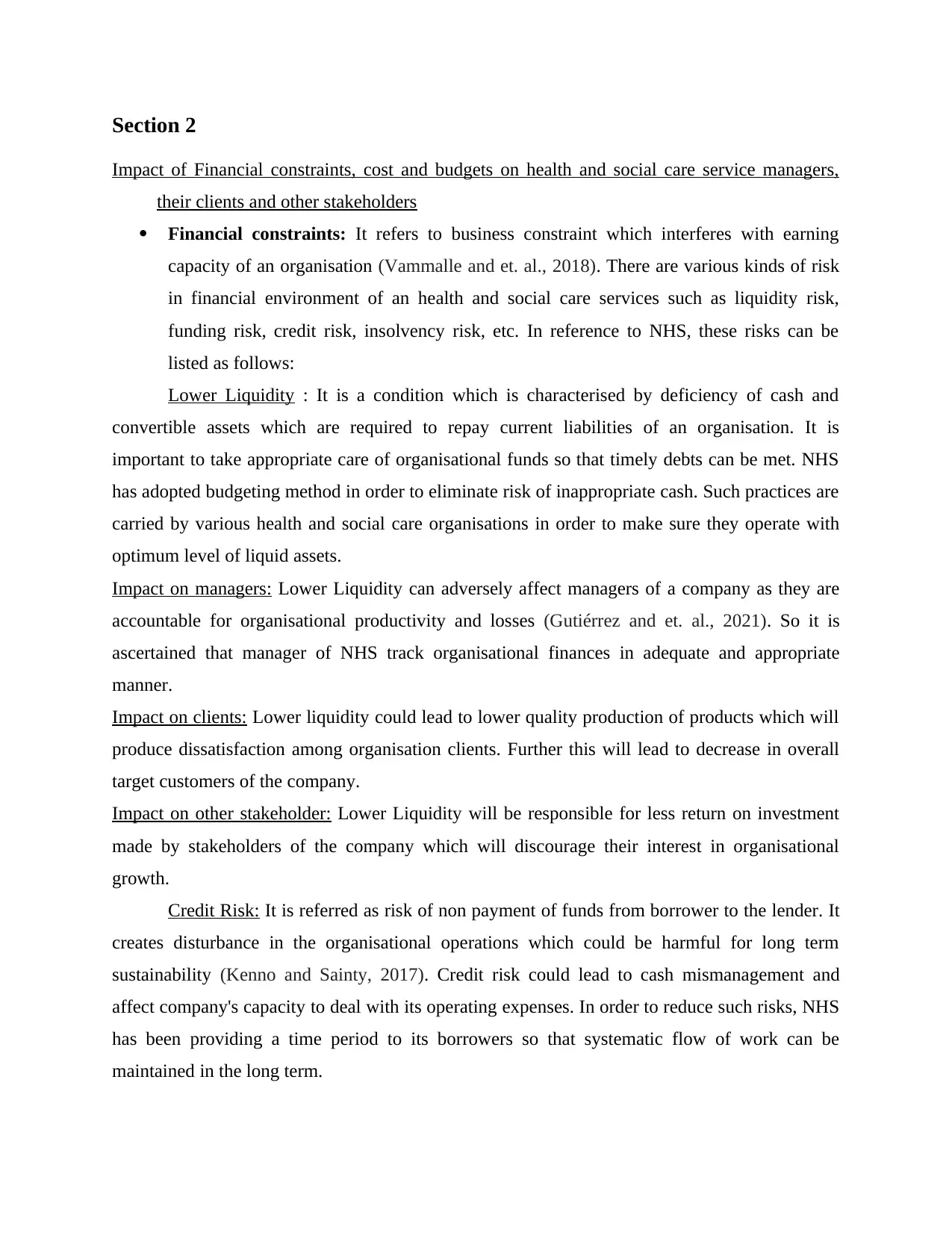
Section 2
Impact of Financial constraints, cost and budgets on health and social care service managers,
their clients and other stakeholders
Financial constraints: It refers to business constraint which interferes with earning
capacity of an organisation (Vammalle and et. al., 2018). There are various kinds of risk
in financial environment of an health and social care services such as liquidity risk,
funding risk, credit risk, insolvency risk, etc. In reference to NHS, these risks can be
listed as follows:
Lower Liquidity : It is a condition which is characterised by deficiency of cash and
convertible assets which are required to repay current liabilities of an organisation. It is
important to take appropriate care of organisational funds so that timely debts can be met. NHS
has adopted budgeting method in order to eliminate risk of inappropriate cash. Such practices are
carried by various health and social care organisations in order to make sure they operate with
optimum level of liquid assets.
Impact on managers: Lower Liquidity can adversely affect managers of a company as they are
accountable for organisational productivity and losses (Gutiérrez and et. al., 2021). So it is
ascertained that manager of NHS track organisational finances in adequate and appropriate
manner.
Impact on clients: Lower liquidity could lead to lower quality production of products which will
produce dissatisfaction among organisation clients. Further this will lead to decrease in overall
target customers of the company.
Impact on other stakeholder: Lower Liquidity will be responsible for less return on investment
made by stakeholders of the company which will discourage their interest in organisational
growth.
Credit Risk: It is referred as risk of non payment of funds from borrower to the lender. It
creates disturbance in the organisational operations which could be harmful for long term
sustainability (Kenno and Sainty, 2017). Credit risk could lead to cash mismanagement and
affect company's capacity to deal with its operating expenses. In order to reduce such risks, NHS
has been providing a time period to its borrowers so that systematic flow of work can be
maintained in the long term.
Impact of Financial constraints, cost and budgets on health and social care service managers,
their clients and other stakeholders
Financial constraints: It refers to business constraint which interferes with earning
capacity of an organisation (Vammalle and et. al., 2018). There are various kinds of risk
in financial environment of an health and social care services such as liquidity risk,
funding risk, credit risk, insolvency risk, etc. In reference to NHS, these risks can be
listed as follows:
Lower Liquidity : It is a condition which is characterised by deficiency of cash and
convertible assets which are required to repay current liabilities of an organisation. It is
important to take appropriate care of organisational funds so that timely debts can be met. NHS
has adopted budgeting method in order to eliminate risk of inappropriate cash. Such practices are
carried by various health and social care organisations in order to make sure they operate with
optimum level of liquid assets.
Impact on managers: Lower Liquidity can adversely affect managers of a company as they are
accountable for organisational productivity and losses (Gutiérrez and et. al., 2021). So it is
ascertained that manager of NHS track organisational finances in adequate and appropriate
manner.
Impact on clients: Lower liquidity could lead to lower quality production of products which will
produce dissatisfaction among organisation clients. Further this will lead to decrease in overall
target customers of the company.
Impact on other stakeholder: Lower Liquidity will be responsible for less return on investment
made by stakeholders of the company which will discourage their interest in organisational
growth.
Credit Risk: It is referred as risk of non payment of funds from borrower to the lender. It
creates disturbance in the organisational operations which could be harmful for long term
sustainability (Kenno and Sainty, 2017). Credit risk could lead to cash mismanagement and
affect company's capacity to deal with its operating expenses. In order to reduce such risks, NHS
has been providing a time period to its borrowers so that systematic flow of work can be
maintained in the long term.
Paraphrase This Document
Need a fresh take? Get an instant paraphrase of this document with our AI Paraphraser
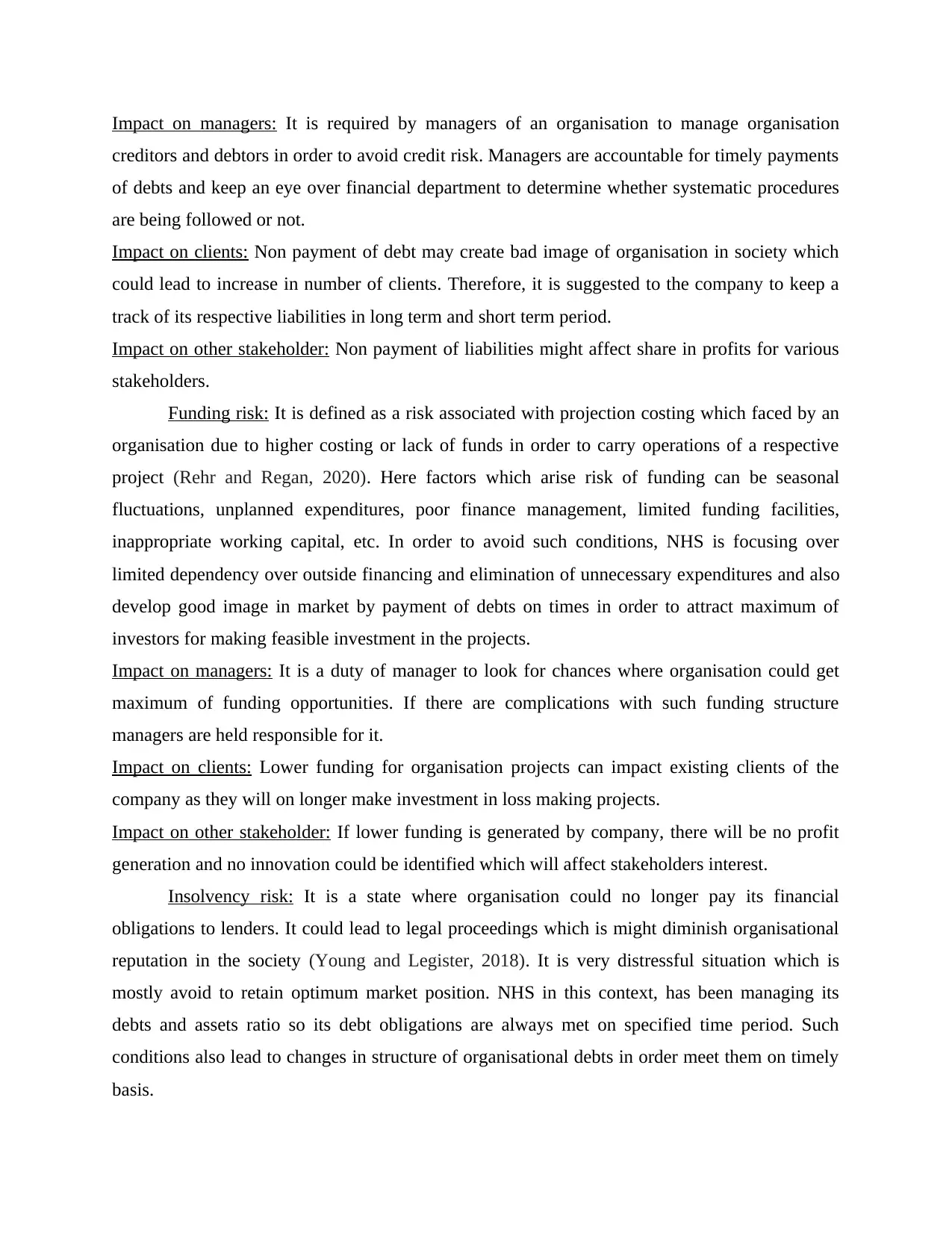
Impact on managers: It is required by managers of an organisation to manage organisation
creditors and debtors in order to avoid credit risk. Managers are accountable for timely payments
of debts and keep an eye over financial department to determine whether systematic procedures
are being followed or not.
Impact on clients: Non payment of debt may create bad image of organisation in society which
could lead to increase in number of clients. Therefore, it is suggested to the company to keep a
track of its respective liabilities in long term and short term period.
Impact on other stakeholder: Non payment of liabilities might affect share in profits for various
stakeholders.
Funding risk: It is defined as a risk associated with projection costing which faced by an
organisation due to higher costing or lack of funds in order to carry operations of a respective
project (Rehr and Regan, 2020). Here factors which arise risk of funding can be seasonal
fluctuations, unplanned expenditures, poor finance management, limited funding facilities,
inappropriate working capital, etc. In order to avoid such conditions, NHS is focusing over
limited dependency over outside financing and elimination of unnecessary expenditures and also
develop good image in market by payment of debts on times in order to attract maximum of
investors for making feasible investment in the projects.
Impact on managers: It is a duty of manager to look for chances where organisation could get
maximum of funding opportunities. If there are complications with such funding structure
managers are held responsible for it.
Impact on clients: Lower funding for organisation projects can impact existing clients of the
company as they will on longer make investment in loss making projects.
Impact on other stakeholder: If lower funding is generated by company, there will be no profit
generation and no innovation could be identified which will affect stakeholders interest.
Insolvency risk: It is a state where organisation could no longer pay its financial
obligations to lenders. It could lead to legal proceedings which is might diminish organisational
reputation in the society (Young and Legister, 2018). It is very distressful situation which is
mostly avoid to retain optimum market position. NHS in this context, has been managing its
debts and assets ratio so its debt obligations are always met on specified time period. Such
conditions also lead to changes in structure of organisational debts in order meet them on timely
basis.
creditors and debtors in order to avoid credit risk. Managers are accountable for timely payments
of debts and keep an eye over financial department to determine whether systematic procedures
are being followed or not.
Impact on clients: Non payment of debt may create bad image of organisation in society which
could lead to increase in number of clients. Therefore, it is suggested to the company to keep a
track of its respective liabilities in long term and short term period.
Impact on other stakeholder: Non payment of liabilities might affect share in profits for various
stakeholders.
Funding risk: It is defined as a risk associated with projection costing which faced by an
organisation due to higher costing or lack of funds in order to carry operations of a respective
project (Rehr and Regan, 2020). Here factors which arise risk of funding can be seasonal
fluctuations, unplanned expenditures, poor finance management, limited funding facilities,
inappropriate working capital, etc. In order to avoid such conditions, NHS is focusing over
limited dependency over outside financing and elimination of unnecessary expenditures and also
develop good image in market by payment of debts on times in order to attract maximum of
investors for making feasible investment in the projects.
Impact on managers: It is a duty of manager to look for chances where organisation could get
maximum of funding opportunities. If there are complications with such funding structure
managers are held responsible for it.
Impact on clients: Lower funding for organisation projects can impact existing clients of the
company as they will on longer make investment in loss making projects.
Impact on other stakeholder: If lower funding is generated by company, there will be no profit
generation and no innovation could be identified which will affect stakeholders interest.
Insolvency risk: It is a state where organisation could no longer pay its financial
obligations to lenders. It could lead to legal proceedings which is might diminish organisational
reputation in the society (Young and Legister, 2018). It is very distressful situation which is
mostly avoid to retain optimum market position. NHS in this context, has been managing its
debts and assets ratio so its debt obligations are always met on specified time period. Such
conditions also lead to changes in structure of organisational debts in order meet them on timely
basis.
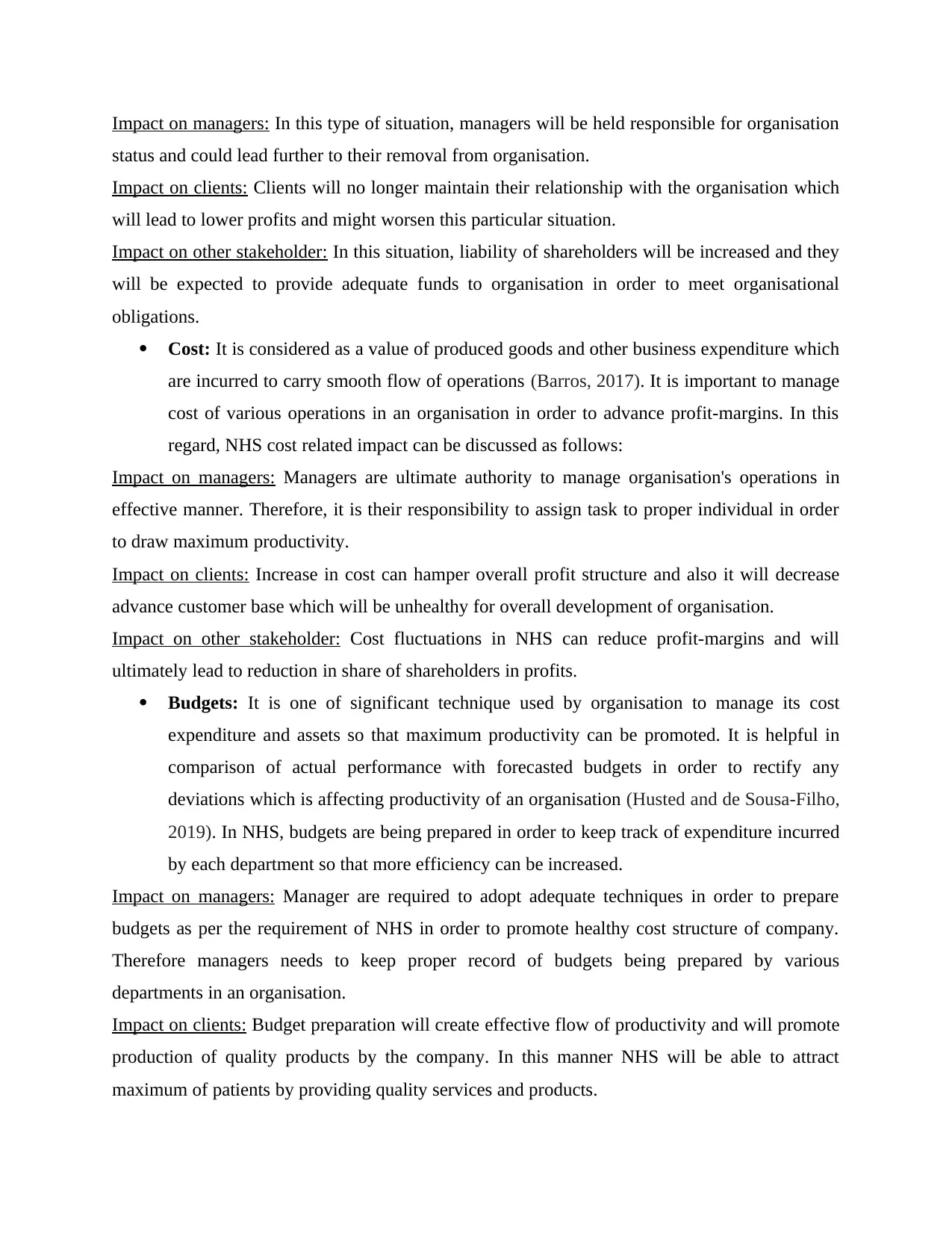
Impact on managers: In this type of situation, managers will be held responsible for organisation
status and could lead further to their removal from organisation.
Impact on clients: Clients will no longer maintain their relationship with the organisation which
will lead to lower profits and might worsen this particular situation.
Impact on other stakeholder: In this situation, liability of shareholders will be increased and they
will be expected to provide adequate funds to organisation in order to meet organisational
obligations.
Cost: It is considered as a value of produced goods and other business expenditure which
are incurred to carry smooth flow of operations (Barros, 2017). It is important to manage
cost of various operations in an organisation in order to advance profit-margins. In this
regard, NHS cost related impact can be discussed as follows:
Impact on managers: Managers are ultimate authority to manage organisation's operations in
effective manner. Therefore, it is their responsibility to assign task to proper individual in order
to draw maximum productivity.
Impact on clients: Increase in cost can hamper overall profit structure and also it will decrease
advance customer base which will be unhealthy for overall development of organisation.
Impact on other stakeholder: Cost fluctuations in NHS can reduce profit-margins and will
ultimately lead to reduction in share of shareholders in profits.
Budgets: It is one of significant technique used by organisation to manage its cost
expenditure and assets so that maximum productivity can be promoted. It is helpful in
comparison of actual performance with forecasted budgets in order to rectify any
deviations which is affecting productivity of an organisation (Husted and de Sousa-Filho,
2019). In NHS, budgets are being prepared in order to keep track of expenditure incurred
by each department so that more efficiency can be increased.
Impact on managers: Manager are required to adopt adequate techniques in order to prepare
budgets as per the requirement of NHS in order to promote healthy cost structure of company.
Therefore managers needs to keep proper record of budgets being prepared by various
departments in an organisation.
Impact on clients: Budget preparation will create effective flow of productivity and will promote
production of quality products by the company. In this manner NHS will be able to attract
maximum of patients by providing quality services and products.
status and could lead further to their removal from organisation.
Impact on clients: Clients will no longer maintain their relationship with the organisation which
will lead to lower profits and might worsen this particular situation.
Impact on other stakeholder: In this situation, liability of shareholders will be increased and they
will be expected to provide adequate funds to organisation in order to meet organisational
obligations.
Cost: It is considered as a value of produced goods and other business expenditure which
are incurred to carry smooth flow of operations (Barros, 2017). It is important to manage
cost of various operations in an organisation in order to advance profit-margins. In this
regard, NHS cost related impact can be discussed as follows:
Impact on managers: Managers are ultimate authority to manage organisation's operations in
effective manner. Therefore, it is their responsibility to assign task to proper individual in order
to draw maximum productivity.
Impact on clients: Increase in cost can hamper overall profit structure and also it will decrease
advance customer base which will be unhealthy for overall development of organisation.
Impact on other stakeholder: Cost fluctuations in NHS can reduce profit-margins and will
ultimately lead to reduction in share of shareholders in profits.
Budgets: It is one of significant technique used by organisation to manage its cost
expenditure and assets so that maximum productivity can be promoted. It is helpful in
comparison of actual performance with forecasted budgets in order to rectify any
deviations which is affecting productivity of an organisation (Husted and de Sousa-Filho,
2019). In NHS, budgets are being prepared in order to keep track of expenditure incurred
by each department so that more efficiency can be increased.
Impact on managers: Manager are required to adopt adequate techniques in order to prepare
budgets as per the requirement of NHS in order to promote healthy cost structure of company.
Therefore managers needs to keep proper record of budgets being prepared by various
departments in an organisation.
Impact on clients: Budget preparation will create effective flow of productivity and will promote
production of quality products by the company. In this manner NHS will be able to attract
maximum of patients by providing quality services and products.
⊘ This is a preview!⊘
Do you want full access?
Subscribe today to unlock all pages.

Trusted by 1+ million students worldwide
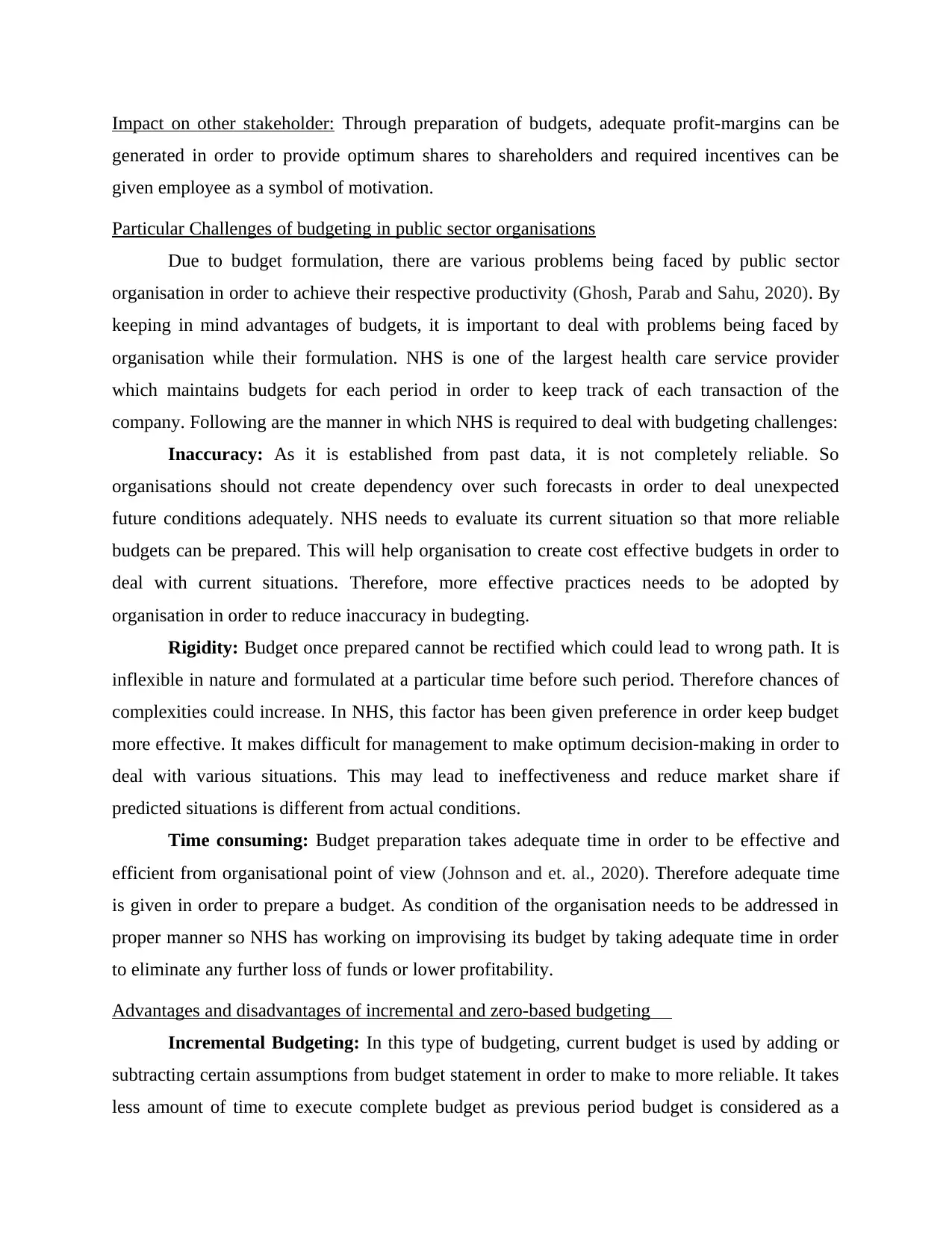
Impact on other stakeholder: Through preparation of budgets, adequate profit-margins can be
generated in order to provide optimum shares to shareholders and required incentives can be
given employee as a symbol of motivation.
Particular Challenges of budgeting in public sector organisations
Due to budget formulation, there are various problems being faced by public sector
organisation in order to achieve their respective productivity (Ghosh, Parab and Sahu, 2020). By
keeping in mind advantages of budgets, it is important to deal with problems being faced by
organisation while their formulation. NHS is one of the largest health care service provider
which maintains budgets for each period in order to keep track of each transaction of the
company. Following are the manner in which NHS is required to deal with budgeting challenges:
Inaccuracy: As it is established from past data, it is not completely reliable. So
organisations should not create dependency over such forecasts in order to deal unexpected
future conditions adequately. NHS needs to evaluate its current situation so that more reliable
budgets can be prepared. This will help organisation to create cost effective budgets in order to
deal with current situations. Therefore, more effective practices needs to be adopted by
organisation in order to reduce inaccuracy in budegting.
Rigidity: Budget once prepared cannot be rectified which could lead to wrong path. It is
inflexible in nature and formulated at a particular time before such period. Therefore chances of
complexities could increase. In NHS, this factor has been given preference in order keep budget
more effective. It makes difficult for management to make optimum decision-making in order to
deal with various situations. This may lead to ineffectiveness and reduce market share if
predicted situations is different from actual conditions.
Time consuming: Budget preparation takes adequate time in order to be effective and
efficient from organisational point of view (Johnson and et. al., 2020). Therefore adequate time
is given in order to prepare a budget. As condition of the organisation needs to be addressed in
proper manner so NHS has working on improvising its budget by taking adequate time in order
to eliminate any further loss of funds or lower profitability.
Advantages and disadvantages of incremental and zero-based budgeting
Incremental Budgeting: In this type of budgeting, current budget is used by adding or
subtracting certain assumptions from budget statement in order to make to more reliable. It takes
less amount of time to execute complete budget as previous period budget is considered as a
generated in order to provide optimum shares to shareholders and required incentives can be
given employee as a symbol of motivation.
Particular Challenges of budgeting in public sector organisations
Due to budget formulation, there are various problems being faced by public sector
organisation in order to achieve their respective productivity (Ghosh, Parab and Sahu, 2020). By
keeping in mind advantages of budgets, it is important to deal with problems being faced by
organisation while their formulation. NHS is one of the largest health care service provider
which maintains budgets for each period in order to keep track of each transaction of the
company. Following are the manner in which NHS is required to deal with budgeting challenges:
Inaccuracy: As it is established from past data, it is not completely reliable. So
organisations should not create dependency over such forecasts in order to deal unexpected
future conditions adequately. NHS needs to evaluate its current situation so that more reliable
budgets can be prepared. This will help organisation to create cost effective budgets in order to
deal with current situations. Therefore, more effective practices needs to be adopted by
organisation in order to reduce inaccuracy in budegting.
Rigidity: Budget once prepared cannot be rectified which could lead to wrong path. It is
inflexible in nature and formulated at a particular time before such period. Therefore chances of
complexities could increase. In NHS, this factor has been given preference in order keep budget
more effective. It makes difficult for management to make optimum decision-making in order to
deal with various situations. This may lead to ineffectiveness and reduce market share if
predicted situations is different from actual conditions.
Time consuming: Budget preparation takes adequate time in order to be effective and
efficient from organisational point of view (Johnson and et. al., 2020). Therefore adequate time
is given in order to prepare a budget. As condition of the organisation needs to be addressed in
proper manner so NHS has working on improvising its budget by taking adequate time in order
to eliminate any further loss of funds or lower profitability.
Advantages and disadvantages of incremental and zero-based budgeting
Incremental Budgeting: In this type of budgeting, current budget is used by adding or
subtracting certain assumptions from budget statement in order to make to more reliable. It takes
less amount of time to execute complete budget as previous period budget is considered as a
Paraphrase This Document
Need a fresh take? Get an instant paraphrase of this document with our AI Paraphraser
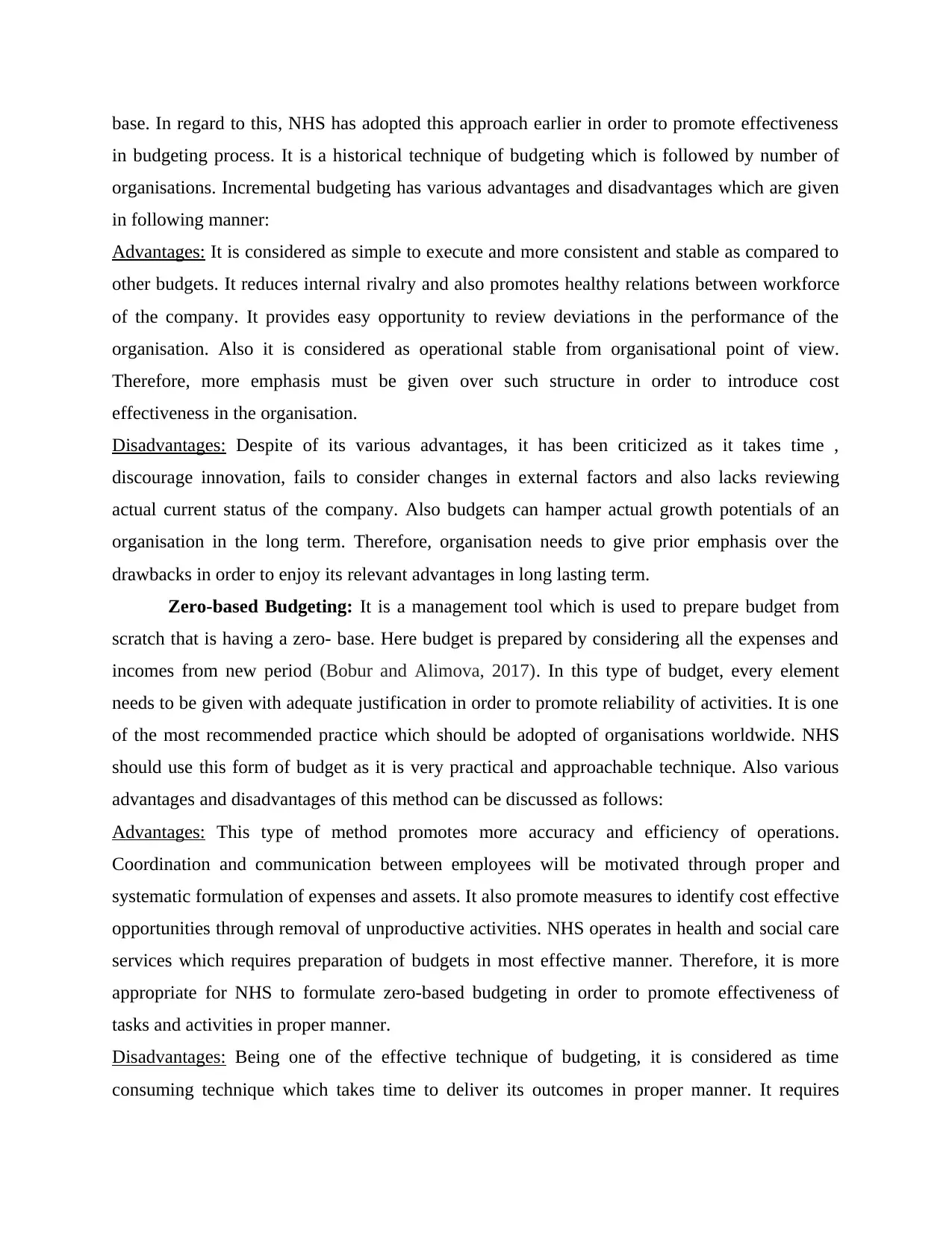
base. In regard to this, NHS has adopted this approach earlier in order to promote effectiveness
in budgeting process. It is a historical technique of budgeting which is followed by number of
organisations. Incremental budgeting has various advantages and disadvantages which are given
in following manner:
Advantages: It is considered as simple to execute and more consistent and stable as compared to
other budgets. It reduces internal rivalry and also promotes healthy relations between workforce
of the company. It provides easy opportunity to review deviations in the performance of the
organisation. Also it is considered as operational stable from organisational point of view.
Therefore, more emphasis must be given over such structure in order to introduce cost
effectiveness in the organisation.
Disadvantages: Despite of its various advantages, it has been criticized as it takes time ,
discourage innovation, fails to consider changes in external factors and also lacks reviewing
actual current status of the company. Also budgets can hamper actual growth potentials of an
organisation in the long term. Therefore, organisation needs to give prior emphasis over the
drawbacks in order to enjoy its relevant advantages in long lasting term.
Zero-based Budgeting: It is a management tool which is used to prepare budget from
scratch that is having a zero- base. Here budget is prepared by considering all the expenses and
incomes from new period (Bobur and Alimova, 2017). In this type of budget, every element
needs to be given with adequate justification in order to promote reliability of activities. It is one
of the most recommended practice which should be adopted of organisations worldwide. NHS
should use this form of budget as it is very practical and approachable technique. Also various
advantages and disadvantages of this method can be discussed as follows:
Advantages: This type of method promotes more accuracy and efficiency of operations.
Coordination and communication between employees will be motivated through proper and
systematic formulation of expenses and assets. It also promote measures to identify cost effective
opportunities through removal of unproductive activities. NHS operates in health and social care
services which requires preparation of budgets in most effective manner. Therefore, it is more
appropriate for NHS to formulate zero-based budgeting in order to promote effectiveness of
tasks and activities in proper manner.
Disadvantages: Being one of the effective technique of budgeting, it is considered as time
consuming technique which takes time to deliver its outcomes in proper manner. It requires
in budgeting process. It is a historical technique of budgeting which is followed by number of
organisations. Incremental budgeting has various advantages and disadvantages which are given
in following manner:
Advantages: It is considered as simple to execute and more consistent and stable as compared to
other budgets. It reduces internal rivalry and also promotes healthy relations between workforce
of the company. It provides easy opportunity to review deviations in the performance of the
organisation. Also it is considered as operational stable from organisational point of view.
Therefore, more emphasis must be given over such structure in order to introduce cost
effectiveness in the organisation.
Disadvantages: Despite of its various advantages, it has been criticized as it takes time ,
discourage innovation, fails to consider changes in external factors and also lacks reviewing
actual current status of the company. Also budgets can hamper actual growth potentials of an
organisation in the long term. Therefore, organisation needs to give prior emphasis over the
drawbacks in order to enjoy its relevant advantages in long lasting term.
Zero-based Budgeting: It is a management tool which is used to prepare budget from
scratch that is having a zero- base. Here budget is prepared by considering all the expenses and
incomes from new period (Bobur and Alimova, 2017). In this type of budget, every element
needs to be given with adequate justification in order to promote reliability of activities. It is one
of the most recommended practice which should be adopted of organisations worldwide. NHS
should use this form of budget as it is very practical and approachable technique. Also various
advantages and disadvantages of this method can be discussed as follows:
Advantages: This type of method promotes more accuracy and efficiency of operations.
Coordination and communication between employees will be motivated through proper and
systematic formulation of expenses and assets. It also promote measures to identify cost effective
opportunities through removal of unproductive activities. NHS operates in health and social care
services which requires preparation of budgets in most effective manner. Therefore, it is more
appropriate for NHS to formulate zero-based budgeting in order to promote effectiveness of
tasks and activities in proper manner.
Disadvantages: Being one of the effective technique of budgeting, it is considered as time
consuming technique which takes time to deliver its outcomes in proper manner. It requires
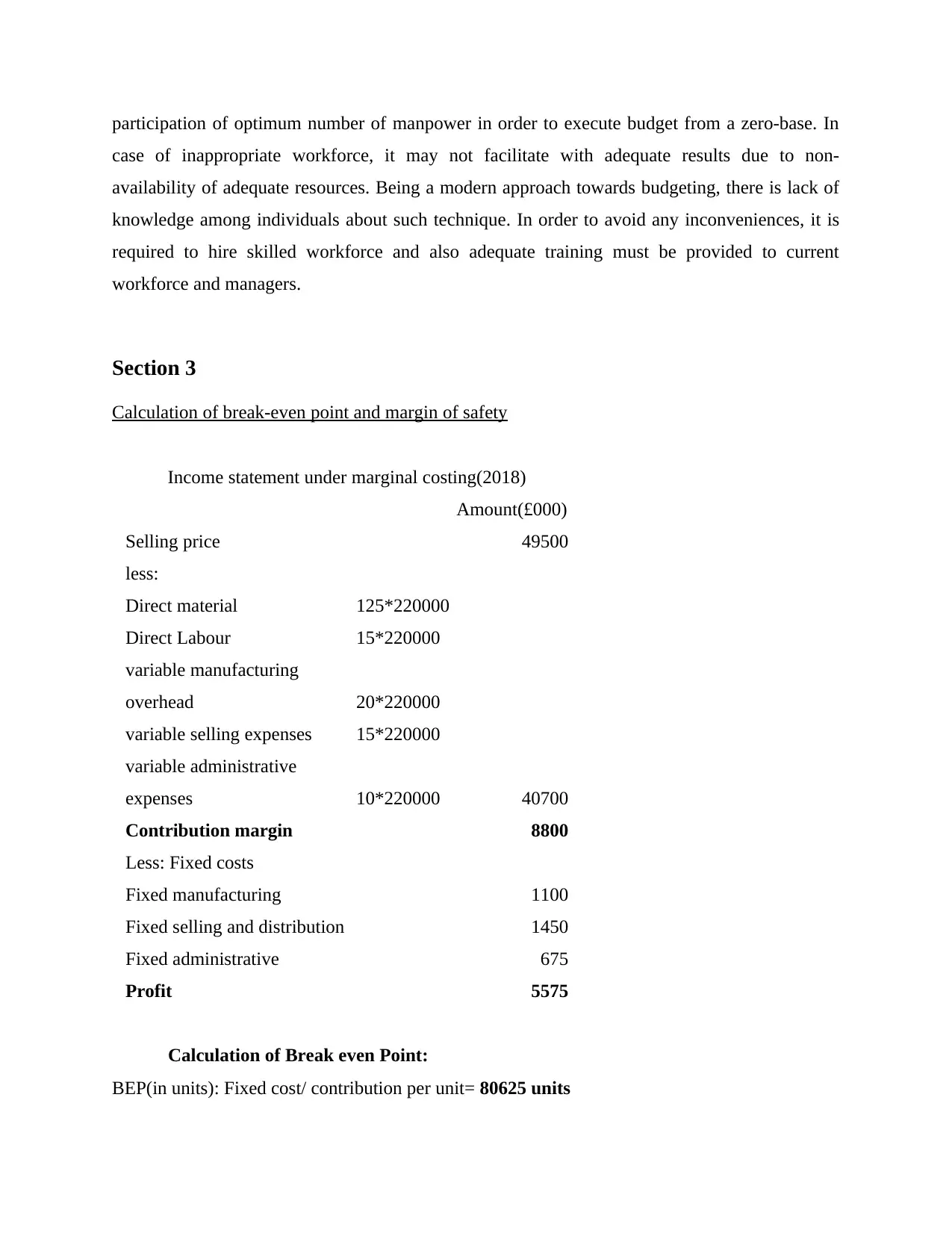
participation of optimum number of manpower in order to execute budget from a zero-base. In
case of inappropriate workforce, it may not facilitate with adequate results due to non-
availability of adequate resources. Being a modern approach towards budgeting, there is lack of
knowledge among individuals about such technique. In order to avoid any inconveniences, it is
required to hire skilled workforce and also adequate training must be provided to current
workforce and managers.
Section 3
Calculation of break-even point and margin of safety
Income statement under marginal costing(2018)
Amount(£000)
Selling price 49500
less:
Direct material 125*220000
Direct Labour 15*220000
variable manufacturing
overhead 20*220000
variable selling expenses 15*220000
variable administrative
expenses 10*220000 40700
Contribution margin 8800
Less: Fixed costs
Fixed manufacturing 1100
Fixed selling and distribution 1450
Fixed administrative 675
Profit 5575
Calculation of Break even Point:
BEP(in units): Fixed cost/ contribution per unit= 80625 units
case of inappropriate workforce, it may not facilitate with adequate results due to non-
availability of adequate resources. Being a modern approach towards budgeting, there is lack of
knowledge among individuals about such technique. In order to avoid any inconveniences, it is
required to hire skilled workforce and also adequate training must be provided to current
workforce and managers.
Section 3
Calculation of break-even point and margin of safety
Income statement under marginal costing(2018)
Amount(£000)
Selling price 49500
less:
Direct material 125*220000
Direct Labour 15*220000
variable manufacturing
overhead 20*220000
variable selling expenses 15*220000
variable administrative
expenses 10*220000 40700
Contribution margin 8800
Less: Fixed costs
Fixed manufacturing 1100
Fixed selling and distribution 1450
Fixed administrative 675
Profit 5575
Calculation of Break even Point:
BEP(in units): Fixed cost/ contribution per unit= 80625 units
⊘ This is a preview!⊘
Do you want full access?
Subscribe today to unlock all pages.

Trusted by 1+ million students worldwide
1 out of 16
Related Documents
Your All-in-One AI-Powered Toolkit for Academic Success.
+13062052269
info@desklib.com
Available 24*7 on WhatsApp / Email
![[object Object]](/_next/static/media/star-bottom.7253800d.svg)
Unlock your academic potential
Copyright © 2020–2025 A2Z Services. All Rights Reserved. Developed and managed by ZUCOL.



